Author :
Abstract
Küresel krizle birlikte, genişletici para politikalarının uygulanması sonucu meydana gelen kredi miktarlarındaki aşırı artış, bankacılık sektörünün verdiği kredilerin gelişigüzel ve özensiz olmasına neden olmuştur. Kredilerin gelişigüzel ve özensiz verilmesi ise verilen kredilerin geri ödenmeme riskini de beraberinde getirmektedir. Kredinin vadesinde ödenmemesi veya ödemenin birkaç gün gecikmesi krediyi sorunlu hale getirmemektedir. Bir kredinin takipteki kredi olarak adlandırılabilmesi için ödememenin veya anlaşmanın bozularak tahsilatın gecikmesi gerekmektedir. Bu çalışmada, bankacılık sektörü kredi büyümesi ile takipteki krediler ilişkisi 2005:Q4-2017:Q4 dönemi üçer aylık verileri kullanılarak analiz edilmiştir. Pesaran vd. (2001) tarafından geliştirilen ARDL modeli kapsamında kısıtlanmamış hata düzeltme modeli (UECM) ve sınır testi yaklaşımı uygulanmıştır. Analiz sonuçlarına göre, takipteki kredilerle bankacılık sektörü kredi büyümesi arasında eş bütünleşme ilişkisi tespit edilmiştir. Ayrıca, uzun dönemde, bankacılık sektörü kredi hacmi arttığında takipteki krediler de artmaktadır. Hata düzeltme terimi katsayısı kısa dönemde beklenildiği gibi negatif ve istatistiksel olarak anlamlı çıkmıştır. Kısa dönem için elde edilen bulgular değerlendirildiğinde, bankacılık sektörü toplam kredi hacminin takipteki krediler üzerinde etkili olduğu tespit edilmiştir.
Keywords
Abstract
Abstract: Due to the global crisis, the excessive increase in the amount of loans resulting from the implementation of expansionary monetary policies caused the loans given by the banking sector to be random and careless. In this case, these loans brings also non-payment risk. Most importantly, even though there is a delay of several days for repayment of the loan at maturity, the loan does not become non-performing loan. In order for a loan to be called as a non-performing loan, the non-payment or agreement is broken and the collection is delayed. In this research study, the association between banking sector credit growth and non-performing loans is investigated using quarterly data for the period 2005: Q4-2017: Q4. Unrestricted error correction model (UECM) is applied within the scope of boundary test approach developed by Pesaran et al. (2001). On the basis of the analysis results, there is a co-integrated relationship between the non-performing loans and the banking sector credit growth. In addition, in the long run, an increase in the banking sector credit size leads non-performing loans to increase. The coefficient of error correction term is negative and statistically significant as expected in the short term. As an evaluation of findings obtained for the short term, it can be considered that the banking sector credit size has an effect on non-performing loans.
Keywords
- Akel, V. ve Gazel, S. (2014). Döviz Kurları ile BIST Sanayi Endeksi Arasındaki Eşbütünleşme
- Akel, V. ve Gazel, S. (2014). Döviz Kurları ile BIST Sanayi Endeksi Arasındaki Eşbütünleşmeİlişkisi: Bir Ardl Sınır Testi Yaklaşımı. Erciyes Üniversitesi İktisadi ve İdari Bilimler Fakültesi Dergisi, 44: 23-41.
- Aktaş, R. (2000). Sorunlu Krediler, TBB Eğitim ve Tanıtım Grubu Seminer Notları, İstanbul, 25-26 Mayıs 2000.
- Brown, R.L. Durbin, J. & Evans, J.M. (1975). “Techniques for Testing the Consistency of Regression Relations Over Time.” Journal of Royal Statistical Society, 37: 149–192.
- Dickey, D.A., & Fuller, W.A. (1981). Likelihood ratio statistics for autoregressive time series with a unit root. Econometrica Journal of the Econometric Society, 49(4), 1057-1072.
- Engle, Robert F. & Clive W.J. Granger; (1987). Cointegration and Error Correction: Representation, Estimation and Testing. Econometrica, 55, pp. 251–76.
- Johansen, Soren; (1988). Statistical Analysis of Cointegration Vectors. Journal of Economics Dynamic and Control, 12(2-3): 231–254.
- Koyuncu, C. ve Saka, B. (2011). Takipteki Kredilerin Özel Sektöre Verilen Krediler ve Yatırımlar Üzerindeki Etkisi. Dumlupınar Üniversitesi Sosyal Bilimler Dergisi, 31: 113-124.
- Messai, A.S. & Jouini, F. (2013). Micro and Macro Determinants of Non-performing Loans, International Journal of Economics and Financial Issues, 3(4), 852-860.
- Narayan S., & Narayan P.K. (2004). Determinants of Demand of Fiji’s Exports: An empirical Investigation. The Developing Economics, XVII-1 95-112.
- Nkusu, M. (2011). Nonperforming Loans and Macrofinancial Vulnerabilities in Advanced Economies. IMF Working Paper, WP/11/161.
- Pesaran M.H., Shin, Y., & Smith, R.J. (2001). Bounds testing approaches to the analysis of level relationships. Journal of Applied Econometrics, 16(3), 289–326.
- Us, V. (2018). Assessment of Bad Loans in Turkey: What Role do Financial Conditions have? Finansal Araştırmalar ve Çalışmalar Dergisi, 10(18): 137-152.
- Vardar, G. ve Özgüler, İ.C. (2015). Short Term and Long Term Linkages among NonperformingLoans, Macroeconomic and Bank-Specific Factors: An Empirical Analysis for Turkey. Ege Akademik Bakış, 15(3): 313-325.
- Taşkın, F. D. (2011). Türkiye'de Ticari Bankaların Performansını Etkileyen Faktörler. Ege Akademik Bakış, 11(2): 289.
- TCMB (2010). Finansal İstikrar Raporu, Aralık-2010. Ankara: Türkiye Cumhuriyet Merkez Bankası.Yüksel, S. (2016). Bankaların Takipteki Krediler Oranını Belirleyen Faktörler: Türkiye İçin Bir Model Önerisi. Bankacılar Dergisi, 98: 41-56.





